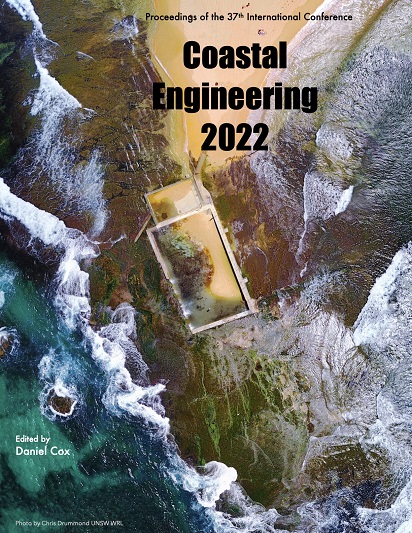Abstract
None of the established formulae for breakwater armour stone stability, Hudson (1958) or van der Meer (1987), explicitly account for the water depth at the toe of the structure. More recently, Hughes (2004), Melby and Hughes (2004), Melby and Kobayashi (2011) have developed equations for stability and runup utilising the concept of wave momentum flux which explicitly accounts for the water depth of the wave probe(s) in close proximity to the structure. The equations are adapted to three forms; namely (1) linear, (2) extended-linear and (3) non-linear. In the paper linearity is assessed by using the Ursell number at each probe depth. Also, due to the placement of probes at various depths in MHL’s 2D wave flume it is possible to correlate the linearity of the wave measurement for the same time series and subsequently test the appropriateness of the momentum flux equation applied for assessment of stability and runup. The stability and runup data from 43 2D physical model tests where stability was previously assessed using van der Meer’s and Hudson’s equations are assessed using the momentum flux equations and an evaluation of the results has been made. It was found that the estimation of notional permeability and selection of the use of the plunging or surging formulae was critical to obtaining a closer match between measurement and prediction. The equations were also utilised in conjunction with numerical models to evaluate the armour size for repair of two breakwater heads in South Camden Haven and Bellambi. The maximum momentum flux equations were found to perform satisfactorily at these locations where the Ursell numbers were found to be high and the waves non-linear.References
Hudson, RY 1959, ‘Laboratory Investigation of Rubble Mound Breakwaters’, Port Coastal and Ocean Engineering, 85(3), 93-121.
Hughes, SA 2004, ‘Wave Momentum Flux Parameter a Descriptor of Nearshore Wave’, Coastal Engineering, 51,1067-1087.
Hughes, SA 2004b, ‘Estimation of Wave Run Up on Smooth Impermeable Slopes using the Wave Momentum Flux Parameter’, Coastal Engineering, 2004.07.026 – Volume 7, World Scientific.
Jayewardene, IFW and Couriel, E 2013, ‘Case Studies in Reconciling Horizontal Wave Force Measurement and Design Forces Using Empirical Functions, Linear and Non-Linear Wave Theory’, 13th Australasian Conference on Coastal and Ocean Engineering, Institution of Engineers Australia, Sydney, September 2013
Jayewardene, IFW, Driscoll, S and Jacobs, R 2009, ‘Assessment of the Repair and Performance of Concrete Armour on Three Breakwater Heads in NSW and Repair to Coffs Harbour Eastern Breakwater’, 18th Australasian Conference on Coastal and Ocean Engineering, Institution of Engineers, Australia, Wellington, New Zealand, August 2009.
Melby, J.A and Hughes, SA 2004, ‘Armour Stability Based on Wave Momentum Flux’, Coastal Structures Conference Proceedings.
Melby, J.A and Kobayashi N, SA 2011, Stone Armour Damage Initiation and Progression Based on the Maximum Momentum Flux, Journal of Coastal Engineering Research.
Shore Protection Manual 1984, Volume 2, Department of Army, Waterways Experimental Station, Coastal Engineering Research Center.
The Rock Manual 2007, CIRIA/CUR Special Publication.
van der Meer, JW 1987, ‘Stability of Armour Layer, Design Formulae’, Coastal Engineering, 11, 219-239, Reston VA, USA
van Gent, MRA, Smale, AJ and Kuiper, C 2004, ‘Stability of Rock Slopes with Shallow Foreshores’ Proceedings of 4th International Coastal Structures Conference Portland, ASCE, 11, 219-239
US Army Corps of Engineers (USACE) 2006, Coastal Engineering Manual, Report No. EM 1110-2-1100, U.S. Army Corps of Engineers, Washington, DC, USA.

This work is licensed under a Creative Commons Attribution 4.0 International License.
Copyright (c) 2023 Indra FW Jayewardene, Aliasghar Golshani, Ed Couriel

